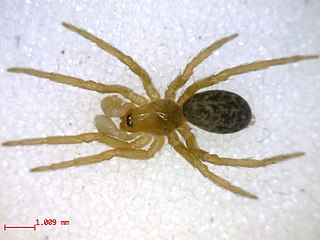
The whistling ducks or tree ducks are a subfamily, Dendrocygninae, of the duck, goose and swan family of birds, Anatidae. In other taxonomic schemes, they are considered a separate family, Dendrocygnidae. Some taxonomists list only one genus, Dendrocygna, which contains eight living species, and one undescribed extinct species from Aitutaki of the Cook Islands, but other taxonomists also list the white-backed duck under the subfamily.

The wandering whistling duck is a species of whistling duck. They inhabit tropical and subtropical Australia, the Philippines, Borneo, Indonesia, Papua New Guinea, and the Pacific Islands.

Chilopsis is a monotypic genus of flowering plants containing the single species Chilopsis linearis. It is known commonly as desert willow or desert-willow because of its willow-like leaves, but it is not a true willow – being instead a member of the catalpa family.

Tettigidea is a genus of groundhoppers or pygmy grasshoppers in the tribe Batrachideini from the Americas. There are at least 40 described species in Tettigidea.

Limaria, the file shells or file clams, is a genus of marine bivalve molluscs in the family Limidae.

Diodora arcuata, common name the arcuate limpet, is a species of sea snail, a marine gastropod mollusk in the family Fissurellidae, the keyhole limpets.

Drepana arcuata, the arched hooktip or masked birch caterpillar, is a moth of the family Drepanidae. The species was first described by Francis Walker in 1855. It is found from Newfoundland to Vancouver Island, south to at least North Carolina, South Carolina and California.

Pyrgotis arcuata is a species of moth of the family Tortricidae. It is endemic to New Zealand.

Macrotera is a genus of bees native to North America, particularly diverse in the desert regions of the United States and Mexico. According to Wilson and Carril, there are "around 30" species of Macrotera. Macrotera are small to medium sized and often black or reddish in coloration. The genus was treated by P.H. Timberlake who, in addition to T.D.A. Cockerell, described most of the known species. Macrotera used to be considered part of the genus Perdita but was split apart by C.D. Michener in 2000. Most species are extreme specialists (oligoleges) with respect to pollen and will only collect pollen from a few closely related species or genera of plants, particularly the plant genus Sphaeralcea and various Cactaceae.

Grallipeza is a genus of stilt-legged flies in the family Micropezidae. There are at least 40 described species in Grallipeza.

Polacantha is a genus of robber flies in the family Asilidae. There are about 10 described species in Polacantha.
Polacantha grossa is a species of robber flies in the family Asilidae.

Cerotoma is a genus of leaf beetles in the family Chrysomelidae. There are about seven described species in Cerotoma. They are found in North America and the Neotropics.
Cutina arcuata, the curve-lined cutina moth, is a species of moth in the family Erebidae. It is found in North America.

Euthycera arcuata is a species of marsh fly in the family Sciomyzidae.
Polacantha composita is a species of robber flies in the family Asilidae.

Cicurina arcuata is a species of true spider in the family Hahniidae. It is found in the United States and Canada.

Polacantha gracilis is a species of robber fly in the family Asilidae.
Milichiella arcuata is a species of freeloader flies in the family Milichiidae.
Dione arcuata, commonly known as eyelash seaweed, is the only species of the red algae genus Dione. The specific name arcuata comes from Latin and refers to the bow-like curved shape of the algae, while the generic name Dione is another name for the goddess Venus. It is made of filaments that are around 1.5 centimeters long; they are curved, wide, and do not split into branches.














